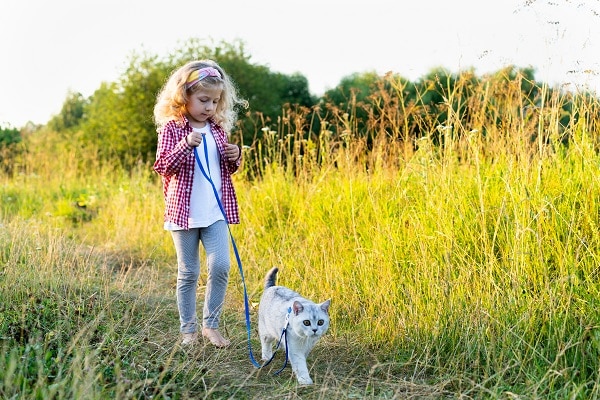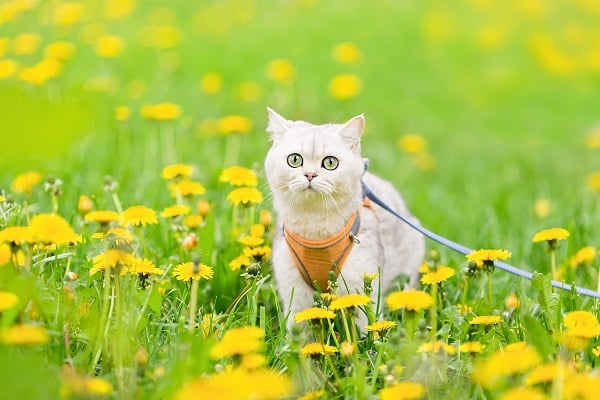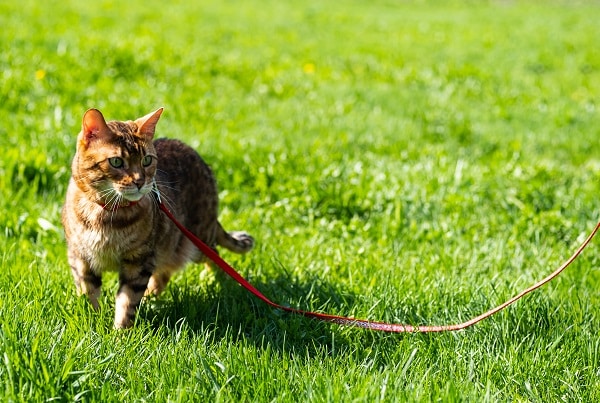Walking a cat often raises eyebrows, as images of leashes, harnesses, and strolls are typically reserved for canine companions. Yet, feline experts have begun to shed light on the myriad benefits that walking can offer to cats. Disregarding this potential exercise can mean missing out on significant health and behavioral advantages for these agile creatures. This blog post will explore the surprising and multifaceted reasons why taking your cat for a walk can be a game-changer for their overall well-being.
Helps Maintain A Healthy Weight

Cats are known for their lounging and sedentary ways, especially indoor cats, which can lead to obesity. With limited space to roam and fewer stimuli to encourage movement, house cats can quickly gain weight, leading to a host of health issues such as diabetes, arthritis, and heart disease. Walking provides the much-needed physical activity that can help keep a cat’s weight in check. By engaging in regular, gentle exercise, cats can burn calories in a controlled and enjoyable manner, ensuring they maintain a healthy weight and reducing the risk of weight-related illnesses.
Moreover, the simple act of walking can fine-tune a cat’s instinctual hunting behavior, requiring the use of various muscle groups. Through the motions of stalking, pouncing, and leaping, a cat on a walk will engage in a natural form of interval training, alternating between moments of intense physical activity and rest. This mimics the energy expenditure patterns in the wild and can be far more effective in maintaining a healthy physique than the sporadic play sessions indoors.
Enhances Mental Stimulation

Cats possess a natural curiosity and a keen instinct to explore their environment, which can be stifled in an indoor setting. By experiencing the outdoors, cats encounter a plethora of stimuli that challenge their senses — from the rustling leaves that tickle their ears to the myriad scents that mark the trails of other animals. This mental stimulation is crucial for their cognitive health and can prevent the lethargy and depression that often plagues indoor cats. Walks can transform into enriching adventures that satisfy their innate curiosity and keep their minds sharp and engaged.
The benefits of mental stimulation are particularly evident in behavioral improvements. Cats that enjoy regular walks often display less aggression and anxiety because their natural behaviors are fulfilled through exploration. The mental exercise obtained from deciphering the outdoor world’s complex stimuli can reduce tendencies toward obsessive-compulsive behaviors, which are frequently a manifestation of boredom and stress. Cats that are mentally stimulated through walking are typically more balanced and content, showcasing the profound impact that such a simple activity can have on their overall demeanor.
Strengthens The Cat-Owner Bond

The relationship between a cat and its owner is unique and can be deepened through shared experiences. Walking together fosters trust and communication, as cats learn to rely on their owners for guidance and safety in the unfamiliar outside world. This creates an opportunity for owners to understand their pets’ body language and behavioral cues more profoundly, leading to a more synchronized and harmonious relationship. The mutual respect and affection that develops during these shared adventures can strengthen the bond in a way that is difficult to replicate through indoor interactions alone.
Additionally, the act of walking a cat requires patience, consistency, and positive reinforcement, which are the building blocks of a strong relationship. Cats that walk with their owners tend to be more attuned to their commands and are often more receptive to training. The shared focus required to navigate the outdoors aids in developing a sense of teamwork between cat and owner. This collaborative dynamic ensures that the bond is not only based on companionship but also on mutual respect and understanding, which is central to any healthy pet-owner relationship.
Reduces Unwanted Behaviors

When cats are confined to the indoors without an outlet for their pent-up energy, they may develop unwanted behaviors such as scratching furniture or excessively vocalizing. These actions are often misread as spiteful or mischievous when, in reality, they are a cry for physical and mental engagement. Walking provides a structured means for cats to expend their energy in a positive and controlled environment. With each step and new discovery, cats can channel their energy into exploring, which in turn diminishes their need to engage in less desirable activities within the home.
Furthermore, walking can greatly contribute to a better night’s sleep for both the cat and the owner. Cats that are active during the day, especially through walking, tend to rest more soundly at night. This routine can greatly reduce the nocturnal antics that many indoor cats exhibit, like running laps around the house or playing with loud toys while owners are trying to sleep. By syncing their activity levels with that of their human counterparts, cats can enjoy a more harmonious household rhythm.
Improves Agility And Physical Coordination

A cat’s physical prowess is one of its most remarkable traits, and walking helps to maintain and improve this agility. As cats navigate different terrains and obstacles, they use muscles that may not be engaged during indoor play. This variety of movement can enhance a cat’s physical coordination and balance, leading to improved agility. The challenge of stepping over logs, leaping onto small ledges, or balancing on uneven surfaces acts as an organic obstacle course, which is not only entertaining but crucial for physical development.
This enhancement of physical skills also contributes to a cat’s confidence and ability to handle themselves in various situations. A cat that is agile and coordinated is less likely to sustain injuries from accidental falls or missteps, both indoors and outdoors. Additionally, the proprioceptive stimulation — the sense that tells where the body is in space — that occurs during a walk can prevent age-related decline in these vital motor capacities. As a result, regular walking can help ensure that cats remain capable and robust throughout their lives.
Promotes Better Litter Box Habits

Regular walking can also influence a cat’s litter box habits, which can be a significant concern for cat owners. Exercise stimulates healthy digestion, which can lead to more predictable and regular elimination. Cats that engage in daily walks may experience fewer instances of constipation or diarrhea, as their bowel movements become more regular. This regularity can translate into a cleaner litter box and a more pleasant living environment, as well as a happier and healthier cat.
Cats thrive on routine, and incorporating walks into their daily schedule can help solidify their internal rhythms, including those concerning their litter box usage. When walks are a consistent part of a cat’s day, they learn to expect and adapt to this routine, which can make them more disciplined in other aspects of their life, such as feeding and elimination. Owners often find that this consistency reduces incidents of inappropriate elimination, a common issue that can be stressful for both the cat and owner.
Provides Safe Outdoor Access

Allowing a cat to explore outdoors can be fraught with risks, such as traffic, predators, or the chance of getting lost. However, walking a cat with a harness and leash can mitigate these dangers, providing a safe framework for outdoor adventure. This controlled exposure allows cats to experience the benefits of fresh air and natural light, which are vital for their well-being, without the risks associated with roaming freely. Moreover, cats with access to the outdoors under supervision are less likely to attempt risky escapes, understanding that they will have time to explore in a safe manner.
The outdoors presents an array of natural scenarios that indoor environments simply cannot replicate. From the tactile sensation of grass under their paws to the chance to chase insects or fluttering leaves, outdoor walking enriches a cat’s sensory experiences. This exposure can boost their immune system by gradually introducing them to various outdoor elements in a controlled way, which can sometimes decrease sensitivity to allergens and bolster overall health.
The Bottom Line
The benefits of walking a cat extend far beyond the initial intention of exercise. It emerges as a holistic activity that contributes significantly to a cat’s physical, mental, and emotional health. Through regular walks, cats not only enjoy a healthy weight and improved physicality but also gain mental stimulation and emotional security. The bond that develops between a cat and its owner during these shared explorations is profound and irreplaceable. As the trend of walking cats gains momentum, it is becoming increasingly clear that this activity can transform the well-being of your feline companions in surprising and meaningful ways.